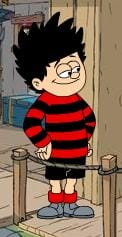The Odd Case of Dennis the Menace
 1951 must have been a very bad year to be named Dennis.
1951 must have been a very bad year to be named Dennis.
The reason is because on March 12 of that year two separate comics entitled Dennis the Menace went on sale, one in the UK, one in the U.S (Note: The UK version is dated March 15 but actually went on sale on March 12).
The UK comic Dennis, which first appeared in Beano #452, was created by David Law and published by D.C. Thomson as a comic strip inside a popular comedy comic book. It’s U.S. counterpart was created by Hank Ketcham and initially distributed by Post-Hall Syndicate as a syndicated comic strip for newspapers.
 Though, based on this simple fact, many draw the conclusion that one of the two creators had to have plagiarized the other, it’s become clear that simply wasn’t the case. Not only did the two creators have no way of knowing what the other was working on, but the two characters are actually extremely different. The UK version is a true menace, a mean-spirited boy who likes to cause trouble, and the U.S. version is happy-go-lucky child that causes trouble without intending to.
Though, based on this simple fact, many draw the conclusion that one of the two creators had to have plagiarized the other, it’s become clear that simply wasn’t the case. Not only did the two creators have no way of knowing what the other was working on, but the two characters are actually extremely different. The UK version is a true menace, a mean-spirited boy who likes to cause trouble, and the U.S. version is happy-go-lucky child that causes trouble without intending to.
The two creators largely agreed to allow each other to work on their respective comics and both are continuing in at least some form today (though the UK version is now known as Dennis and Gnasher, named after Dennis’ dog). Though the U.S. version may be the most popular internationally, the UK version is better known in its native country. No legal action has been taken against either creator.
Still, the coincidence is one of the best-known in the publishing world and was recently highlighted on Cracked. However, it also highlights one of the most difficult aspects of plagiarism detection, trying to separate what is a plagiarism and what is a coincidence. Sometimes, it can be nearly impossible to be certain.
Proof of Coincidence
Though I’m not usually one to believe in coincidences, and it’s always possible that both creators independently drew their idea from the same or a similar source, there is definitely a great deal of proof that the similarities were not intentional.
- No Opportunity: Both comics were created well before the Internet and there is no proof the creators ever saw one another’s work. Separated by an ocean, there’s simply no chance either were aware what the other was doing.
- Key Differences: Other than the name, the two characters have nothing in common. The UK version is a bully, the U.S. version is an ordinary, albeit at times annoying, child.
- Nothing Gained: As catchy as the name is, there was nothing gained by having two otherwise unrelated characters be named Dennis the Menace. It would only create confusion and ensure neither had sole dominion over the name. As pointed out by Cracked, one simply could have changed the name and no one would have suspected they ever had anything in common.
In short, even though it’s clear with nearly 60 years of perspective that the two Dennises have nothing in common other than their name. It should have also been clear in 1951 and, by all accounts, was both creators simply agreed to continue with their characters without making any changes.
Still, the case highlights just how strange some coincidences can be when dealing with plagiarism.
Bottom Line
What are the odds of two Dennis the Menace comic strips appearing on the same day on opposite sides of the ocean? Almost nothing.
However, it happened and in a universe as big as ours strange coincidences are bound to happen. Separating what is chance from what is intentional requires more than just identifying what’s similar, it involves looking at what’s different, what would be gained by the copying, if plagiarism is even possible and what the parties involved have to say. Even with that, it sometimes comes down to a judgment call based on experience, intuition and education.
While most clear-cut cases of plagiarism can be detected as such easily, as can most cases of modified plagiarism, many cases need a deeper look to fully grasp what’s going on. As with the Dennis the Menace case, often times you find out that the answer is just chance, nothing more.
The universe, sometimes, can be a very strange place.
Want to Reuse or Republish this Content?
If you want to feature this article in your site, classroom or elsewhere, just let us know! We usually grant permission within 24 hours.
